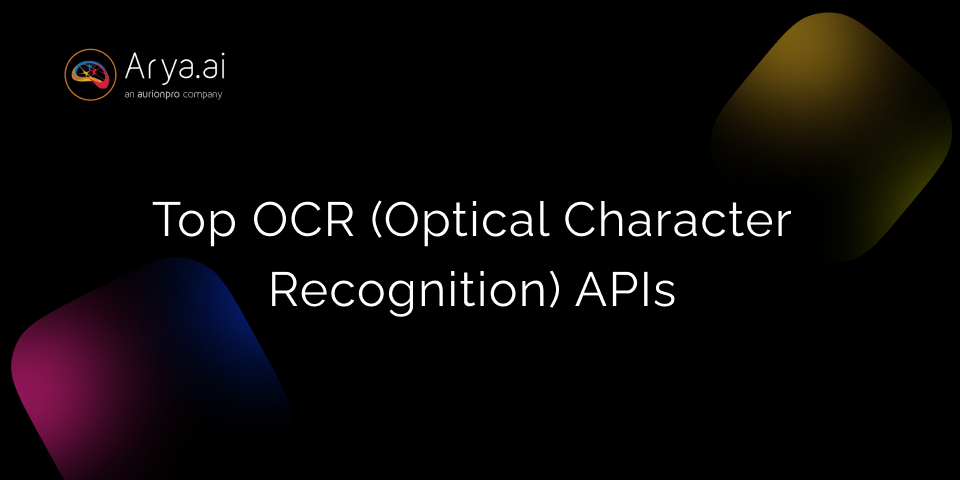Optical Character Recognition (OCR) technology is changing the way we interact with text and data. The technology has multiple applications. OCR in banking negates the need for manual data extraction from financial statements and documents by automating it.
Thus, as we advance, OCR APIs are becoming more powerful and accessible, enabling developers and businesses to integrate advanced text recognition capabilities into their applications seamlessly. The further integration of AI in creating AI-powered OCR systems is making document indexing, data extraction, and information interpretation faster and more accurate.
This blog post explores the top 15 OCR APIs, highlighting their unique features, strengths, and how they can benefit your projects. Let’s dig in!
Understanding the Best OCR API Options Right Now
Choosing the right Optical Character Recognition (OCR) API can feel like a big task. We're here to help you sort through the top options available today.
- Arya AI APIs
Arya AI’s AI-powered OCR APIs leverage deep learning to provide high-accuracy text recognition. It offers custom model training to adapt to specific use cases and supports a range of languages and scripts. Arya AI focuses on providing scalable and efficient AI solutions, making their OCR API suitable for businesses looking to incorporate advanced AI capabilities into their applications. Explore the AI APIs marketplace for use-case-specific solutions such as invoice extraction, bank statement analysis, KYC extraction, and more.
- Tesseract OCR
Tesseract is an open-source OCR engine developed by Google. It shines in performance across multiple languages and scripts. The tool is regularly updated to improve efficiency and accuracy. As an open-source solution, it is widely accessible and empowers developers who want to customize their OCR capabilities without heavy upfront costs.
- Google Cloud Vision OCR
Google Cloud Vision OCR offers seamless integration with Google's suite of cloud services, which makes it very appealing for companies already invested in the Google environment. It excels in image recognition and supports robust extraction features. This API is well-documented, ensuring developers can quickly find the community support they might need.
- Azure Computer Vision OCR
Microsoft’s Azure Computer Vision OCR handles complex image processing tasks adeptly. It provides high customization options, making it versatile for different industry needs. Azure also emphasizes security and compliance, which is crucial for businesses handling sensitive data.
- Amazon Textract
Amazon Textract is a powerful OCR service that goes beyond simple text extraction to also identify tables, forms, and even handwriting. It integrates smoothly with other AWS services, making it a strong choice for businesses already using Amazon's cloud ecosystem. Amazon Textract uses machine learning to deliver high accuracy, especially in processing structured data.
- ABBYY Cloud OCR SDK
ABBYY Cloud OCR SDK is known for its high accuracy and support for a wide range of languages and document types. It offers robust features like barcode recognition, field-level data extraction, and PDF conversion, making it suitable for enterprise-level applications. ABBYY's technology is renowned for its precision in text recognition and data capture.
- OCR.space API
OCR.space provides a free OCR API for developers, supporting multiple languages and offering options for text recognition from images and PDFs. It's user-friendly and does not require registration for basic use, making it accessible for small projects and rapid development. It also offers advanced features like auto-rotation and table recognition in its paid versions.
- Nanonets OCR API
Nanonets OCR API leverages machine learning to automate data extraction from documents. It allows for custom model training, which can improve accuracy for specific use cases. It’s particularly useful for processing invoices, receipts, and other structured documents. Nanonets provides an easy-to-use interface and supports integration with various programming languages.
- Veryfi OCR API
Veryfi OCR API is designed to extract data from receipts, invoices, and other financial documents. It offers high-speed processing and is optimized for mobile and web applications needing instant data capture and processing. Veryfi emphasizes security and compliance, which is essential for handling sensitive financial information.
- IBM Watson Visual Recognition
IBM Watson Visual Recognition includes OCR capabilities within its suite of AI services. It can classify images and extract text, and it's known for its machine-learning capabilities that allow for custom model training. IBM Watson provides robust analytics and integration options, making it suitable for complex applications.
- Adobe Document Cloud OCR
Adobe Document Cloud OCR provides robust OCR services integrated with Adobe's document management tools. It's highly accurate and is particularly strong in converting scanned documents into editable PDFs. Adobe's OCR is well-suited for businesses that frequently work with PDF documents and need reliable text extraction.
- Iron OCR
Iron OCR is a .NET OCR library that allows developers to add OCR functionality to their .NET applications. It supports multiple languages and provides high accuracy in text recognition from images and PDFs. Iron OCR is known for its ease of integration into .NET projects and its comprehensive support.
- Cloudmersive OCR API
Cloudmersive OCR API offers advanced OCR capabilities with support for over 100 languages. It's known for its ease of integration and high accuracy in text extraction from images and PDFs. Cloudmersive provides a scalable solution with robust security features, making it suitable for applications that require processing large volumes of documents.
- Klippa OCR API
Klippa OCR API specializes in processing receipts, invoices, and identity documents. It provides fast and accurate data extraction, making it suitable for financial applications and identity verification processes. Klippa emphasizes ease of use and offers SDKs for multiple programming languages.
- EasyOCR
EasyOCR is an open-source OCR tool that supports over 80 languages. It's easy to use and integrates well with Python applications, making it a good choice for developers needing a flexible and customizable OCR solution. EasyOCR is known for its quick setup and the ability to recognize a variety of scripts and fonts.
Evaluating OCR API Solutions
Let’s outline the criteria you must use to judge OCR APIs:
- Unique Selling Point (USP): What sets the API apart?
- User Experience and Interface: How easy is it to use and navigate?
- Integration and Compatibility: How well does the API work with existing systems and other software?
- AI Tech and Customization: What AI capabilities are included, and how customizable is the API?
- Performance: How quickly and accurately does it perform?
- Reliability: Is the API dependable for critical tasks?
- Accuracy and Error Rate: How precise is the text extraction process?
- Cost Comparison: How does the pricing model stack up against competitors?
- Learning Curve: How steep is the learning curve for new users?
- Customer Support: What support options are available for troubleshooting and optimization?
Advances in OCR Technology: What's New In 2025?
- AI models in OCR are smarter and more precise.
- OCR works faster now, minimizing delays.
- More languages are supported, expanding user reach.
Enhanced AI Algorithms
Artificial Intelligence has drastically changed OCR technology. New AI algorithms now offer greater accuracy, even with low-quality images. The foundation of these improvements lies in advanced machine learning models. These models learn from vast datasets to predict text accurately, even if parts of the image are obscured or blurry.
- Deep Learning Contributions
Deep learning using neural networks plays a key role in understanding context and structure. It allows OCR systems to interpret not just letters but whole words, phrases, and sentences in different languages. By doing so, OCR can handle complex scripts like Mandarin or Arabic, which previously posed challenges.
Real-Time Processing
Real-time processing capabilities in OCR have progressed significantly. Today's systems can process text on the go within seconds, a necessity in fast-paced environments. As businesses demand immediate data to make split-second decisions, OCR technology has responded by minimizing latency.
Higher Language Support
Language support in OCR has expanded beyond common languages, addressing the needs of global users. Previously, languages like Japanese or Thai posed significant challenges due to their intricate scripts. The shift toward advanced modeling techniques and recognition patterns now allows OCR to identify and extract these texts accurately. Moreover, with intelligent character recognition, it becomes even easier to detect complex handwritten text.
OCR API Use Cases in 2025
- Streamlining document management processes saves time.
- Mobile apps become more functional with integrated OCR.
- Accessibility features enhance user engagement and inclusivity.
Document Management
Businesses constantly handle large volumes of documents. OCR APIs transform scanned documents into editable text, which cuts down the time spent on manual data entry. For example, a bank can use OCR to scan loan applications and automatically input customer data into its system. This not only speeds up the process but also reduces human error. The automation of this task can lead to increased productivity and efficiency across departments.
Streamlining Business Processes
Centralizing information from different document types into one internal system is another benefit. Once the data is extracted, it can be used to generate reports, analyze trends, or even trigger automated workflows. For instance, hospitals can digitize patient records, making it easy to access and update information when needed. The real-world example includes automation in accounting firms where invoices and receipts get processed without delay.
Improving User Experience
Good user experience is pivotal for app retention. Integrating OCR enhances how consumers engage with apps. For example, travel apps can use OCR to scan and store ticket information from an email attachment. The technology thus helps in improving app functionality and user satisfaction.
Conclusion
The landscape of OCR APIs in 2025 is rich with potential. As AI algorithms enhance accuracy and real-time processing becomes the norm, OCR is no longer just a tool—it's a gateway to digital transformation.
Consider how OCR can revolutionize your workflow. Whether you're streamlining document management, boosting mobile app functionality, or enhancing accessibility, the right OCR solution awaits. The future trends point towards AI-driven, cloud-based, and industry-specific adaptations.
Your next step? Choose an OCR API that aligns with your needs and start experimenting. The power to turn images into actionable data is at your fingertips.





